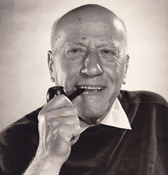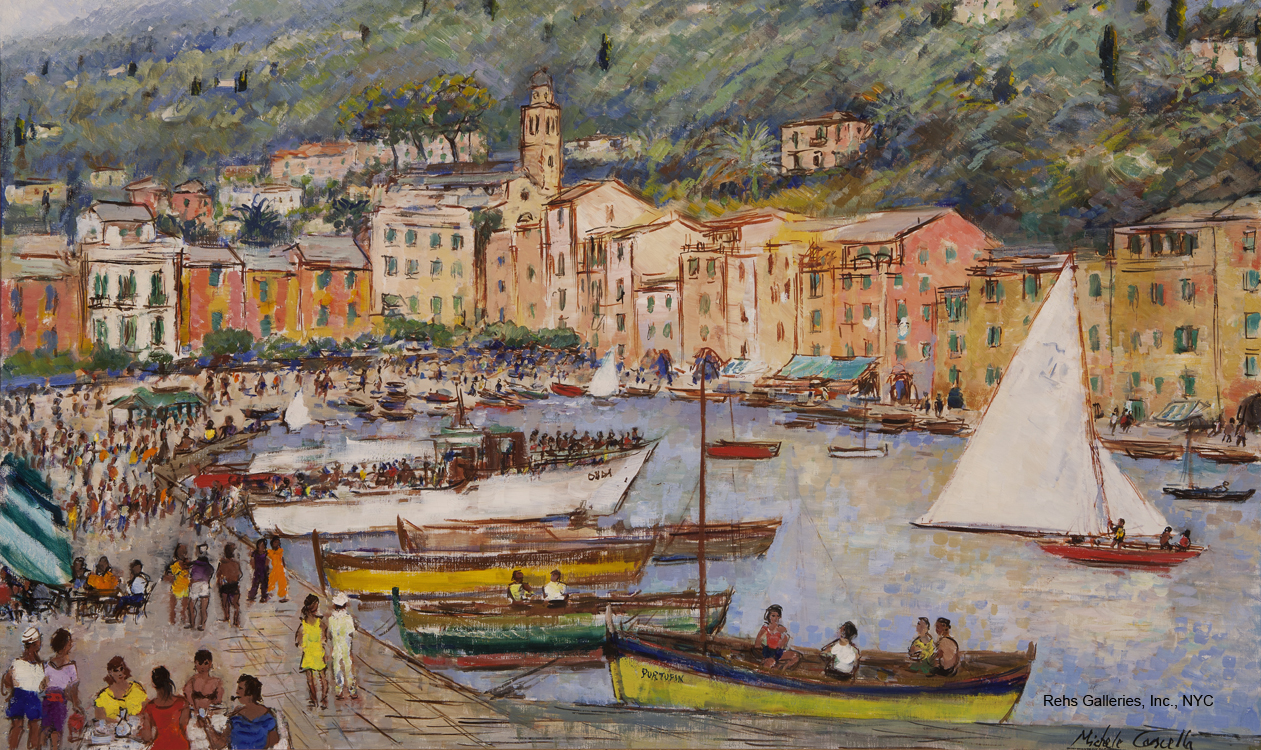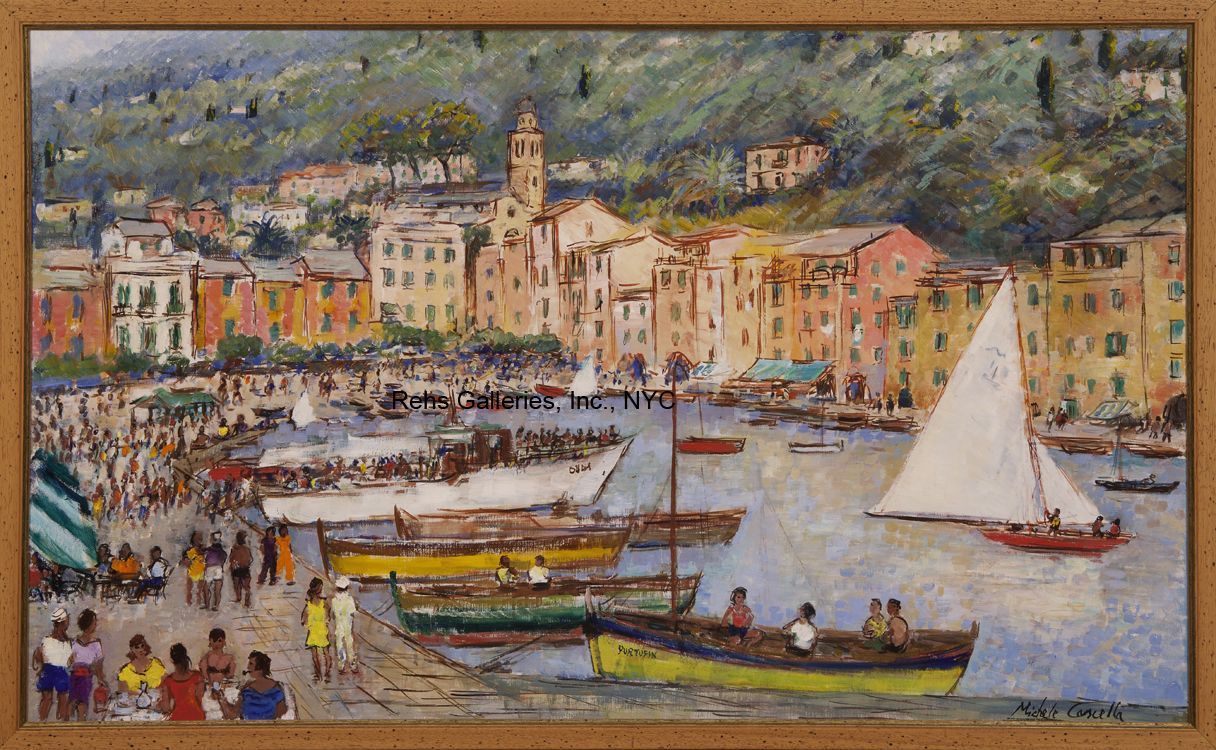Michele Cascella
(1892 - 1989)
Sunday Afternoon in Portofino
Oil on canvas
30 x 50 inches
Signed
BIOGRAPHY - Michele Cascella (1892 - 1989)

Cascella was born in Ortona a Mare (Province of Chieti), in the Abruzzo region of Italy on September 7, 1892. He was the second of 7 children (3 boys and 4 girls). Michele’s father, Basilio Cascella, was also born in Ortona in 1860, as was his grandfather, Francesco Paolo Cascella, who was a tailor for women. Michele’s mother, Concetta Palmerio, was from Guardiagrele, the daughter of a very popular veterinarian in the area at the time.
Michele’s father was his first and most influential teacher. Basilio was a painter, engraver, ceramist, lithographer and illustrator. Before Michele was born, he lived and worked in Naples, Milan, Turin, Venice, London and Palermo. In 1895, Basilio moved the family from Ortona to Corso Manthone in Pescara opposite Gabriele d'Annunzio's house. The Pescara city council gave Basilio a piece of land to build a chromolithographic laboratory and art studio. This building today is the site of the Museo Civico "Basilio Cascella". It holds more than 500 works belonging to three generations of the Cascella family. Most of the works are Basilio’s, the others are of his sons Tommaso, Michele and Gioacchino and the two sons of Tommaso, Andrea and Pietro, who became well known sculptors. In 1899, Basilio began publishing the magazine L'illustrazione abruzzese, then L'illustrazione meridionale and finally La Grande Illustrazione. Among the collaborators to these publications were some of the most important literary figures of the times, such as Gabriele d’Annunzio, Luigi Pirandello, Umberto Saba, Gennaro Finamore, Filippo Tommaso Marinetti, Sibilla Aleramo, Matilde Serao, Grazia Deledda, Ada Negri, Guido Gozzano and Giovanni Pascoli.
Michele finished elementary school with difficulty and his teacher said his head was always in the clouds. The following year, after his art teacher humiliated him in front of the class, he abandoned school entirely. His mother, who was deeply religious, wanted him to follow an ecclesiastic career, but his father who was a socialist and very antireligious, wanted him to become an artist, like himself. Right away Michele began to work in his father’s chromolithographic laboratory in Pescara. Basilio put Michele to work filling the backgrounds of the designs on the lithographic stone, with the black graphic ink, Lorilleux. Michele would often turn the star-shaped wheel of his father’s press and was involved in the various lithographic processes of transfers and proofs. Meanwhile Basilio had Michele copy the drawings of the masters (Leonardo, Pisanello, Botticelli, and Donatello) or simplifications of large mouths and noses which Basilio prepared specifically for Michele to practice over and over again. Michele was very proud and happy to be working for his father and he was becoming very familiar with the tools of the trade. Basilio was not able to paint from nature very well himself, so to compensate for this lack of ability, he taught his sons from the beginning to work in the open air, from the real, to see, to grasp and to interpret the language of nature. Soon Basilio would send Michele and Tommaso alone, at dawn, on foot to the shores of the Pescara River and the surrounding hills or by coach to the Majella to study the scenery from close by. They brought only their boxes of pastels, some bread and a caciocavallo (cheese), so they could stay out all day to paint.
When Basilio felt his sons were ready to show their work, he shifted his role from shop master to organizer and promoter of their art. Michele had now been out of school and working for his father for almost 5 years. Their first show was held in Milan at the Famiglia Artistica in Via San Raffaele in 1907, far from their provincial cultural limits. Basilio wanted to expose Michele and Tommaso to a more stimulating environment, richer with activity and possibilities. There was talk of "Enfants prodiges". Michele was only 15 years old.
Michele sold his first painting privately in 1908 and had his first show in Paris the following year. His technique mainly consisted in the use of pastels. In 1910, Michele began to frequent the cultural circles of Milan, where he became friends with the poet Clemente Rebora, as well as the philosopher Antonio Banfi and the writer Sibilla Aleramo, who in her turn introduced him to Filippo Tommaso Marinetti, Umberto Boccioni and Margherita Sarfatti. Giorgio de Chirico also became a friend of his. Michele presented the pastel La casa blu to the Biennale of Venice without success. Shortly after, Eduadro de Filippo, the great theater actor, comedian, and director, bought it. In 1912 Michele’s father opened another studio in Milan on Viale Monza #26. Most of the family remained in Pescara. Basilio made illustrations for a magazine Nature and Art for the Antonio Vallardi Publishing House. By 1914 Michele was having an affair with Sibilla Aleramo, who was 16 years older than he was. She was 38 at the time. He was 22. He met her while working on his father's magazine L'illustrazione abruzzese, to which he had contributed drawings and graphic illustrations.
In 1915 at the start of the World War I Italian Campaign Michele was mobilized and sent to the front in the Trentino, but he did not stop painting. In fact, General Enrico Caviglia, his commander, gave him the job of drawing the life of the soldiers at the front. One evening, at the command headquarters in Chiut Zuin two foreign deserters arrived, an officer and a simple soldier. They were Russian. The moon was coming up behind them, when they arrived, they were both of an unreal light yellow color similar to hay, from head to toe. He made a little drawing and upon his return to Pescara he painted a small piece entitled The Russian Soldiers, 1915. Some of these scenes of military life at the front are today preserved in the Museum of the Risorgimento in Milan.
In 1917 Basilio moved with his sons to Rapino where he dedicated himself to ceramics. In 1919 Michele moved to Milan where he shared an apartment with his friend and inspiration, the poet Clemente Rebora in Via Tadino, #8. Michele dedicated himself to engraving and ceramics, later returning to oil and watercolor painting. In 1923 Michele was finishing a watercolor of a fountain in a Piazza in Palermo, when he heard an older woman turn to her friend and say: "Look what he has to do to eat, poor guy!".[citation needed] In 1924 Carlo Carrà, who was a great supporter of the primitivism in Michele's paintings, gave him good reviews. That same year, Michele exhibited three watercolors at the Venice Biennale for the first time and one of them, Mattutino, was bought by King Victor Emmanuel. From that year on until 1942, Michele participated, at almost all the Venice Biennale exhibitions, except for 1938. In 1928 Michele made his first trip to Paris, even though he had held several exhibits there already, and he exhibited in Brussels. Michele considered Paris his second home from then on. Life there reminded him of certain areas of Italy.
In 1931 Michele participated at the first Rome Quadriennale, along with his father, and continued to participate at all the Quadriennales until 1951. In April Michele exhibited 28 paintings at the Bastford Gallery in London and he met the architect Alfred C. Bossom who bought three paintings. He then donated the watercolor The entrance to the village, to the Victoria and Albert Museum. Still that same year Michele exhibited at the Toison d'Or Gallery in Brussels and in June, the Belgian Minister of The Sciences and Arts stated that it had acquired his painting, Evening at Montecatini.
In 1933 the director of the Corriere della Sera, Aldo Borelli, invited Michele to collaborate on the newspaper with a series of sketches of important Italian localities. Almost every day, the paper published one of his drawings. After Michele’s military experience, pen and ink sketches had become his favorite method of expression. On June 4, 1933, pushed by his father and with special dispensation of a friend, Michele was able to paint the canonization ceremony of Andrew Fournet in St. Peter's Basilica. Though Michele initially thought this painting was a flop, Antonio Mariaini (Dacia Maraini's grandfather), then secretary of the Venice Biennale, had it displayed prominently there the following year. The Italian King, Victor Emanuel, wanted to buy it, but Michele put a very high price on it for that time. The royal family offered only half of what Michele was asking, which Michele refused because of an excess of pride. Later on he regretted it, because he could not find a buyer for it. In 1934 Michele went to Libya for a few months and shortly afterwards Michele received a commission from Maria-José, Princess of Piedmont for a series of paintings dedicated to southern Italian landscapes. She gave him itinerary tips from Amalfi to Sila. The Civic Gallery of Modern Art in Turin acquired his Sera a Montecatini Alto.
In 1937 Stefano Benni, then Minister of Transportation, wanted Michele to do the wall decoration for the new Maritime station of Messina. Michele thought his father would be better suited for this job, but ended up accepting it. He agreed only to do the sketch and had his father and brother, Tommaso, do the actual execution. He also won the gold medal at the Universal Exposition in Paris. At the Permanente in Milan, Michele exhibited Roma, sport esultanza, inspired by the 1933 Primo Carnera-Paulino Uzcudun boxing match held in Rome's Piazza di Spagna in the presence of Benito Mussolini. In 1938 Michele did the designs for the premiere of Licinio Refice's opera Margherita da Cortona, at La Scala. He then began to reside in Portofino which became the inspiration for many of his later works.
In 1942 Michele had a room at the Biennal of Venice, his last year there, and he exhibited works made at the request of the Ministers of the Navy and of the Air Force.
In 1955 Michele designed the costumes for La moglie saggia by Carlo Goldoni, shown at the Sant’Erasmo Theater under the direction of Carlo Lari. The French State bought the watercolor Piazzola di Padova and Michele’s native town of Ortona a Mare gave him and his brothers a gold medal and held a celebratory exhibition.
In October 1959 Michele made his first trip to the U.S., to New York. From then on he would spend half of the year in Palo Alto, California, where Isabel Lane became his agent and organized all of his shows. Later Michele was represented by the Juarez Gallery in Los Angeles.
In 1965, while in Ortona, Michele dedicated a painting to the Apostle San Tommaso, whose remains are preserved in the Cathedral there, and gave it to the then mayor, who in turn donated the painting to His Holiness Paolo VI.
In 1967, Michele traveled to Hawaii for the holidays. Michele’s brother, Tommaso, died in Pescara in 1968 and the following year Garzanti published Forza zio Mec, a short autobiography written by Michele while he was in the U.S.
From 1969 Michele spent much of his time in the countryside of Colle Val d’Elsa (province of Siena) with his second wife, Isabel Lane Cascella. He painted many Tuscan landscapes during this period.
In 1972, the Comune of Milan gave Michele a gold medal of merit.
In 1975 in Pescara the Museo Basilio Cascella was opened in the original location of Michele’s father’s lithographic establishment, with works of Basilio, his sons and grandsons. During the same year, Portofino made Michele an honorary citizen.
In 1977 the city of Ortona dedicated the Pinacoteca Comunale to Michele which exhibits around 50 of his paintings.
In 1980, the Comune of Milan gave Michele the medal of merit.
Michele died on Tuesday, August 31, 1989 at the age of 97 in Milan and was buried in Ortona. In 2003 Michele was featured in the collective exhibition, De Chirico et la peinture italienne de l’entre-deux guerres (De Chirico and Italian Painting of the Interwar Period) at the Musee de Lodeve.
Michele Cascella was a very congenial and humane person, as well as a tenacious worker. The techniques Michele used were pastels, pencil and pen and ink drawings, oils, watercolors, ceramics, lithography and textiles. His most frequent subjects were flowers, portraits and the landscapes of Abruzzi, locations all over Italy, Portofino, Paris, London, New York, California, Mexico, Hawaii, Tuscany. Michele himself said that Henry Rousseau and Picasso had the greatest impact on the art world, while Van Gogh, Utrillo and Raoul Dufy most influenced his own work.
Selected Museums
Basilio Cascella Civic Museum in Pescara
Pinacoteca Comunale Michele Cascella in Ortona
Museum of the Risorgimento in Milan
Victoria and Albert Museum in London
Gallery of Modern and Contemporary Art in Turin
Banca Nazionale del Lavoro in Rome
Galerie nationale du Jeu de Paume in Paris
National Museum of History and Art in Luxembourg
Museo casa natale Gabriele D'Annunzio in Pescara
The De Saisset Art Gallery (Permanent Collection), Santa Clara University in California
Museum of Modern Art in Brussels
Galleria Nazionale d'Arte Moderna in Rome.


